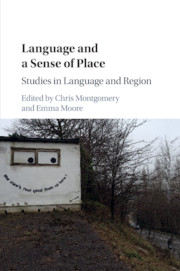Book contents
- Language and a Sense of Place
- Language and a Sense of Place
- Copyright page
- Contents
- Figures
- Tables
- Contributors
- Preface and Acknowledgements
- Introduction
- Part I Changing Places
- 1 Changing Places
- 2 Changing Sounds in a Changing City
- 3 Local vs. Supralocal
- 4 Variation and Change in the Realisation of /r/ in an Isolated Northumbrian Dialect
- Part II Describing Places
- Part III Identifying Places
- Part IV Enregistering Places
- Index
- References
4 - Variation and Change in the Realisation of /r/ in an Isolated Northumbrian Dialect
from Part I - Changing Places
Published online by Cambridge University Press: 13 July 2017
- Language and a Sense of Place
- Language and a Sense of Place
- Copyright page
- Contents
- Figures
- Tables
- Contributors
- Preface and Acknowledgements
- Introduction
- Part I Changing Places
- 1 Changing Places
- 2 Changing Sounds in a Changing City
- 3 Local vs. Supralocal
- 4 Variation and Change in the Realisation of /r/ in an Isolated Northumbrian Dialect
- Part II Describing Places
- Part III Identifying Places
- Part IV Enregistering Places
- Index
- References
- Type
- Chapter
- Information
- Language and a Sense of PlaceStudies in Language and Region, pp. 87 - 104Publisher: Cambridge University PressPrint publication year: 2017
References
References
Websites and Media
- 2
- Cited by



